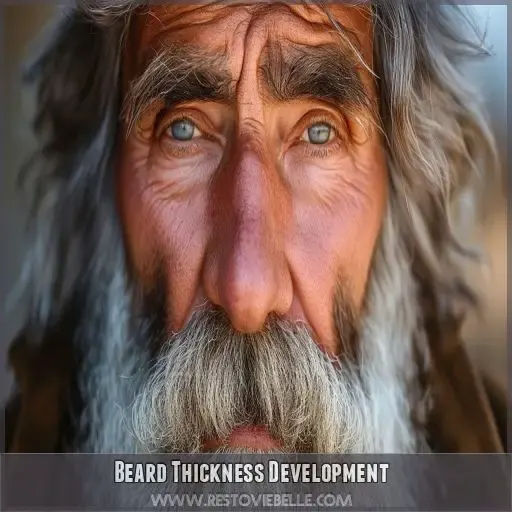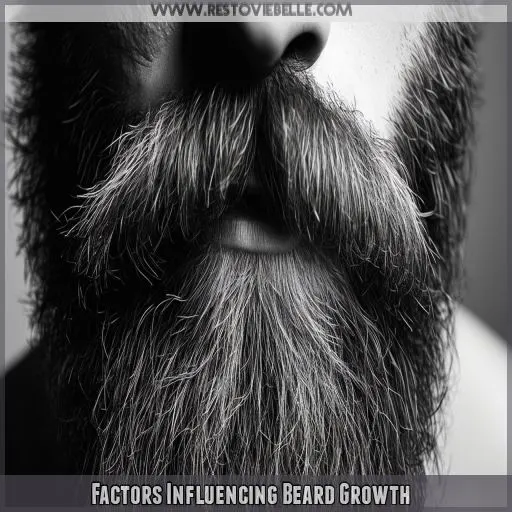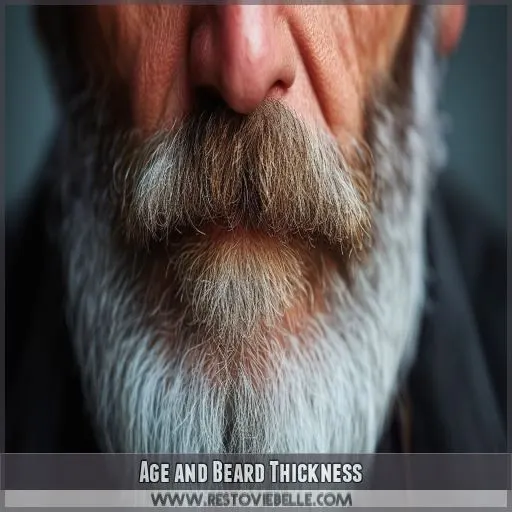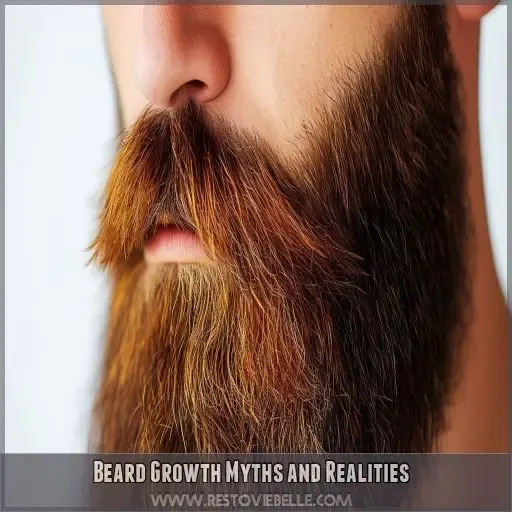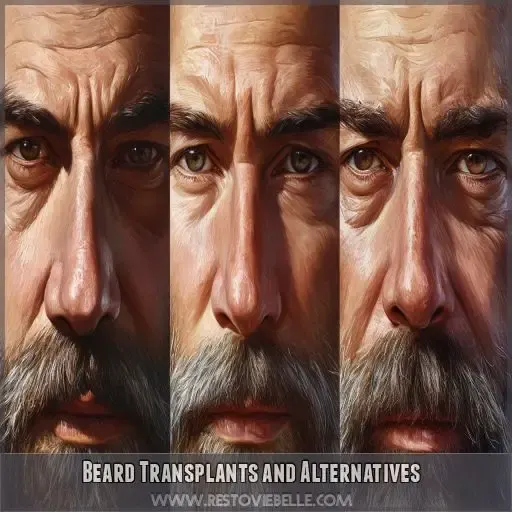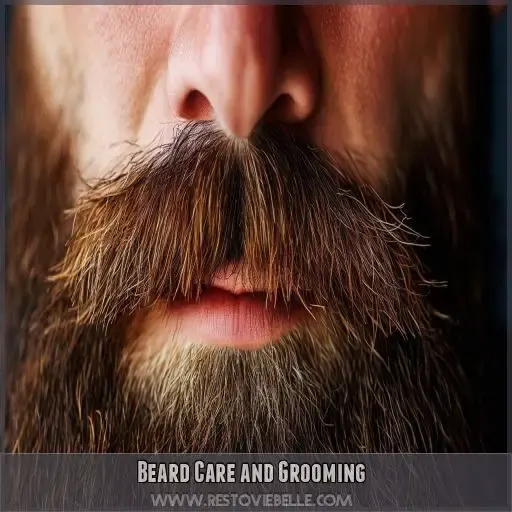This site is supported by our readers. We may earn a commission, at no cost to you, if you purchase through links.
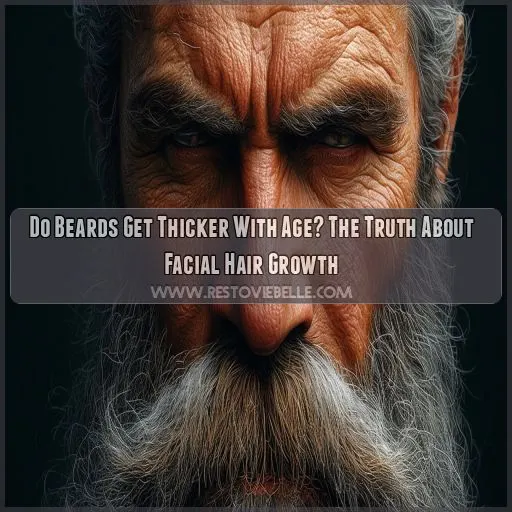 Imagine your beard to be like a fine wine, potentially getting better with age. Do beards get thicker with age? Obviously, if you are looking to grow a fuller beard, you will want answers to this question.
Imagine your beard to be like a fine wine, potentially getting better with age. Do beards get thicker with age? Obviously, if you are looking to grow a fuller beard, you will want answers to this question.
The reality is that it all boils down to the science of facial hair growth. Genetics, hormonal changes, lifestyle, and nutrition are extremely critical factors in determining how thick your beard is going to be over time.
Grasping these factors can help you master the journey toward a fuller and healthier beard. Dive deeper to unlock how your beard evolves over the years.
Table Of Contents
- Key Takeaways
- Do Beards Get Thicker With Age?
- Beard Thickness Development
- Factors Influencing Beard Growth
- Age and Beard Thickness
- Health Conditions and Beard Thinning
- Beard Growth Myths and Realities
- Beard Transplants and Alternatives
- Beard Care and Grooming
- Frequently Asked Questions (FAQs)
- At what age does a beard get thicker?
- Does a beard grow thicker over time?
- What age does a beard stop filling in?
- Does your beard get thicker in your 40s?
- Can daily shaving darken my beard?
- How do beard dyes impact hair health?
- Does sun exposure affect beard color?
- What role does humidity play in beard care?
- Are there benefits to using a boar bristle brush?
- Conclusion
Key Takeaways
- Your beard, like a fine wine, has the potential to improve with age.
- Genetics and hormones play a major role in determining how thick your beard will be.
- A healthy lifestyle and good nutrition can support beard growth.
- If you’re looking for a thicker beard, you may want to consider a transplant.
Do Beards Get Thicker With Age?
As you age, beards typically get thicker, especially in your twenties and thirties, thanks to ongoing maturation and changing hormone levels.
Testosterone and DHT (dihydrotestosterone) play significant roles in facial hair growth, with many men seeing an increase in beard density as these hormones stabilize.
Genetics also heavily influence how thick your beard gets with age. However, don’t ignore factors like nutrition, stress management, and regular grooming, which can optimize beard health.
While sudden thinning could indicate an underlying health issue, consistent care can keep your beard at its best.
Want to know the secrets behind achieving a thicker beard? Let’s uncover them together.
Beard Thickness Development
Your beard doesn’t have a set breadth. As you age, you will find that your beard grows according to its thickness and changes in facial hair density. Testosterone and DHT levels do have an effect on thicker or faster-growing beards, depending on the levels in the individual.
Ethnic variations can also play a role. But at its core, it’s just genes. Nonetheless, good nutrition and low stress can certainly give vibrancy to your hair follicles.
Just enjoy the natural process and show care for its good health.
Factors Influencing Beard Growth
Your genetic makeup, hormonal changes, and lifestyle choices play key roles in beard growth. Embrace a balanced diet, regular exercise, and manage stress to support healthy facial hair development.
Genetics
Genetics play a pivotal role in your beard’s growth patterns and maturity. Ethnic differences and family history largely determine hair follicle number and thickness. Mediterranean or Middle Eastern ancestry typically results in denser beards. Your genetic makeup will dictate stages of beard growth, though thinning may occur as you age.
Hormonal Changes
Hormonal regulation plays an important role in beard growth. How your facial hair matures will be dictated mainly by the levels of testosterone and DHT in your body. Monitor:
- Thyroid problems: As a result, imbalances may influence growth.
- Exercise: Increases testosterone levels in the natural way.
- Stress: The more, the higher the levels of cortisol, which inhibits DHT.
- Hormones: Any sudden changes may be indicative of ill health.
Lifestyle and Nutrition
Nourish your beard with a balanced diet rich in protein, zinc, and vitamin D. Regular exercise boosts blood flow to hair follicles, while managing stress helps regulate hormones. Stay hydrated – it’s essential for healthy hair growth. Beard transplants offer an option for those seeking thicker facial hair.
| Diet | Exercise |
|---|---|
| Protein, zinc, vitamin D | Increases blood flow |
| Stress Management | |
| — | |
| Regulates hormones |
Age and Beard Thickness
Beard growth continues to mature in your twenties and thirties, potentially becoming thicker over time. However, the peak thickness varies widely among individuals, with some experiencing notable changes and others seeing little difference.
Beard Growth in Twenties and Thirties
In your twenties and thirties, your beard typically becomes thicker, driven by hormonal changes and lifestyle factors. A balanced diet, regular exercise, and effective stress management can enhance growth. While genetics play a role, paying attention to your health and wellness can influence the growth rate and overall appearance of your beard.
Changes in Thickness Over Time
With age, your beard may undergo very slight thickness changes. Some men see a gradual increase; others find it stays the same or thins out. It greatly depends on ethnicity, nutrition, the ability to handle stress, and the kind of life one has lived. Frequent care keeps facial hair in maximum thickness.
Peak Beard Thickness Variability
Peak beard thickness can vary widely among different men. Some may reach peak thickness in early twenties, while others are late bloomers, maturing into their thirties. Genetic variation and hormonal fluctuations play key roles. Here are four factors that influence peak age:
- Genetics
- Hormone levels
- Diet
- Stress
Health Conditions and Beard Thinning
Health conditions like diabetes and thyroid problems can lead to unexpected thinning of your beard. If you notice sudden changes in your beard’s thickness, it might be a sign to check your health.
Diabetes and Thyroid Problems
If you notice your beard thinning, diabetes or thyroid problems could be behind it. These health conditions often cause unexpected hair loss, affecting not just your beard but other body hair too.
Diabetes can mess with your blood sugar levels, adding stress to your body and impacting beard health. Similarly, thyroid imbalances disrupt hormone production, leading to hair loss.
Regular check-ups and managing these conditions can help maintain your beard’s thickness and overall health.
Unexpected Thinning as a Sign of Health Issues
If you feel that your beard is thinning, it could be a symptom of underlying health problems. Diabetes and disorders of the thyroid gland may lead to early thinning and consequent hair loss. It’s essential to have your thyroid levels checked on a regular basis, as an imbalance can drastically change beard growth. Diabetes causes thinning not just in your beard but also in your eyebrows and body hair in the armpits. If this is a change you’re noticing, seek immediate attention from your doctor. They will be able to help pinpoint causes and offer solutions to address the underlying issues.
Beard Growth Myths and Realities
Contrary to popular belief, shaving doesn’t make your beard grow back thicker; it only gives the illusion of thickness as the hair grows back with a blunt tip. Cold weather can stimulate hair growth slightly, but it won’t drastically change the thickness of your beard.
Impact of Shaving
It is a fact that shaving frequency doesn’t affect beard regrowth in terms of thickness. Maybe it’s just the appearance when it’s starting to grow back that makes one think his beard grows back thick.
Still, this comes down to simple hair physiology due to being cut bluntly. When you incorporate proper shaving techniques and better shaving tools in your routine, you’re ensuring yourself a smoother shave with reduced irritation and implicating skin health.
Note that your growth rate and thickness are genetically predetermined, so enjoy the grooming ritual without any fussing over such things as one usually tends to worry about in these matters.
Influence of Cold Weather
While shaving myths are pretty common, another one that’s quite popular is the idea that cold weather will make your beard grow. Somehow, the colder the temperature, the faster your beard will grow. This isn’t actually true, seeing as beard growth is mainly influenced by things like genetics and hormones—not by climate.
Although one might feel a little more fullness in the beard during winter, owing to less-sweating skin and reduced oil production, the real effect of cold weather on growing the beard is pretty minimal. Take care of it right, nourish it well, and here you are—into the best results.
Beard Transplants and Alternatives
If you’re struggling with a patchy or thin beard, you may be considering a beard transplant. However, there are also other potential options to help achieve a thicker, fuller facial hair look.
Considerations for Beard Transplants
Thinking of a beard transplant? There are a few things you should consider. You’ll want to factor in the following:
- Transplant options: Variations of the techniques – FUE or FUT – give different results.
- Cost concerns: These can be relatively high, from a few thousand to over ten thousand dollars.
- Recovery process: This will take some weeks, during which time some swelling and redness may appear normal in the early stages.
- Beard after transplant care: Gentle washing without any aggravation and avoiding direct sun exposure will help.
- Risks: Possible infections or rare scarring.
Potential Options for Thicker Beards
If you’re looking to achieve a thicker beard, you have options. Beard implants are a reliable solution, especially if genetics aren’t in your favor. These implants involve transplanting hair follicles for a fuller look.
Alternatively, consider Minoxidil treatments, which can stimulate hair growth and thickness over time. Combine these approaches with a healthy lifestyle, including a balanced diet and stress management, to maximize results.
Whether you opt for implants or other treatments, patience and consistency are key.
Beard Care and Grooming
Regular grooming is crucial for maintaining a healthy and attractive beard. Using beard oils, balms, and washes can keep your beard nourished, conditioned, and clean.
Importance of Regular Grooming
Regular grooming is essential for maintaining a healthy, well-kept beard. Here are four key grooming techniques to incorporate into your beard care routine:
- Cleanse with a specialized beard wash to remove dirt, oil, and odor.
- Condition with a nourishing beard oil to soften and tame flyaways.
- Style with a beard balm to provide hold, shine, and a polished look.
- Trim and shape your beard to accentuate your facial features.
Consistent grooming will keep your beard looking its best and promote healthy growth.
Use of Beard Oils, Balms, and Washes
Beard oils, balms, and face washes are essential for beard care. The former hydrates facial locks, making them silky to avoid itchiness and dandruff. The latter controls styling and adds extra moisturizing properties for a reachable, full beard look. A quality beard wash is used regularly to clean up the beard from dirt accumulation.
These beard grooming techniques serve not only to enhance the beard’s look but also to prepare the way for healthier growth, speaking of mastery in beard care.
Frequently Asked Questions (FAQs)
At what age does a beard get thicker?
Your beard generally thickens as you enter your twenties and thirties, with growth patterns maturing during this time. Peak thickness varies, often continuing until your forties, after which it may plateau or slow down.
Does a beard grow thicker over time?
Yes, your beard can grow thicker over time, especially in your twenties and thirties, due to the continued influence of hormones and genetics. However, lifestyle factors and overall health play significant roles in beard growth.
What age does a beard stop filling in?
Most men’s beards stop filling in around their mid-40s or 50s as testosterone levels decline. However, genetics and lifestyle factors can impact when your beard reaches its peak thickness.
Does your beard get thicker in your 40s?
In your 40s, your beard might get thicker, but it often plateaus. Hormonal changes affect growth, and genetics play a significant role. Maintaining a healthy lifestyle can still support a fuller beard.
Can daily shaving darken my beard?
Daily shaving doesn’t darken or thicken your beard. This is a myth. Shaving only cuts hair at the surface, but it doesn’t impact the thickness, color, or growth rate of your beard.
How do beard dyes impact hair health?
Beard dyes are like a double-edged sword – they can temporarily darken your facial hair, but excessive use may dry out and damage the delicate follicles over time. Moderation is key for healthy, vibrant beard growth.
Does sun exposure affect beard color?
Yes, sun exposure can lighten your beard color. Ultraviolet (UV) rays break down melanin in hair, causing it to fade. Regular exposure can lead to a lighter or slightly reddish tint over time.
What role does humidity play in beard care?
Does humidity affect your beard’s health? Absolutely. High humidity can keep your beard hydrated, prevent brittleness, and reduce frizz, ensuring a smoother, healthier appearance. Embrace the moisture for a better beard care routine.
Are there benefits to using a boar bristle brush?
Using a boar bristle brush can gently exfoliate your skin, distribute natural oils evenly, and leave your beard feeling softer and more manageable. It’s a simple way to elevate your grooming routine.
Conclusion
Much like a good bottle of wine, your beard can indeed get thicker with age. Understanding the science behind facial hair growth, from genetics to hormonal changes, will help you navigate this journey.
Be mindful of health conditions that might impact your beard’s thickness and debunk myths around grooming practices.
With proper care, nutrition, and possibly exploring transplants, you can achieve a fuller beard. Your quest for a thicker beard starts with informed choices and consistent grooming.

